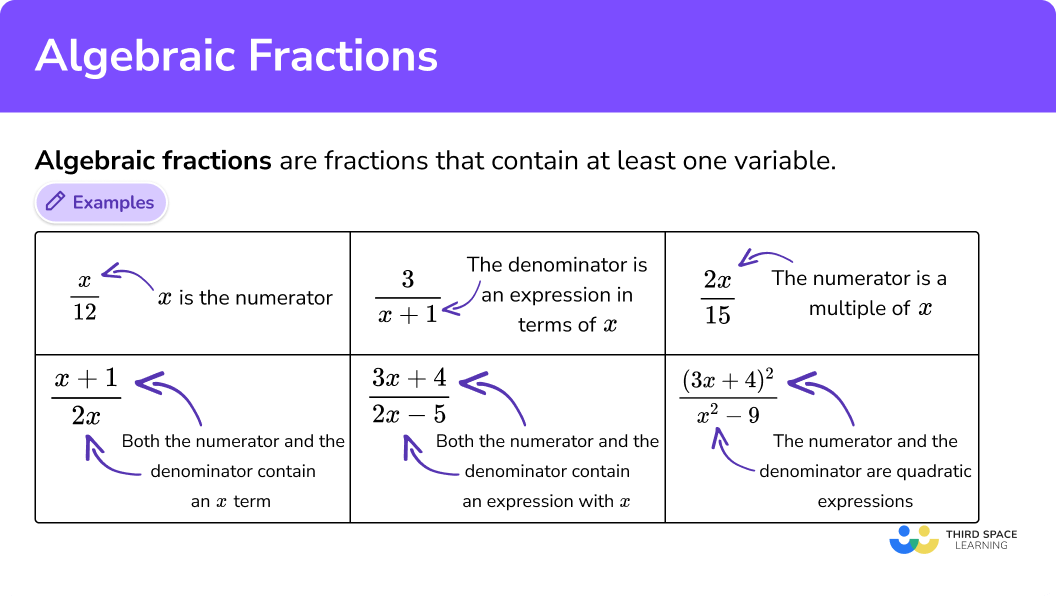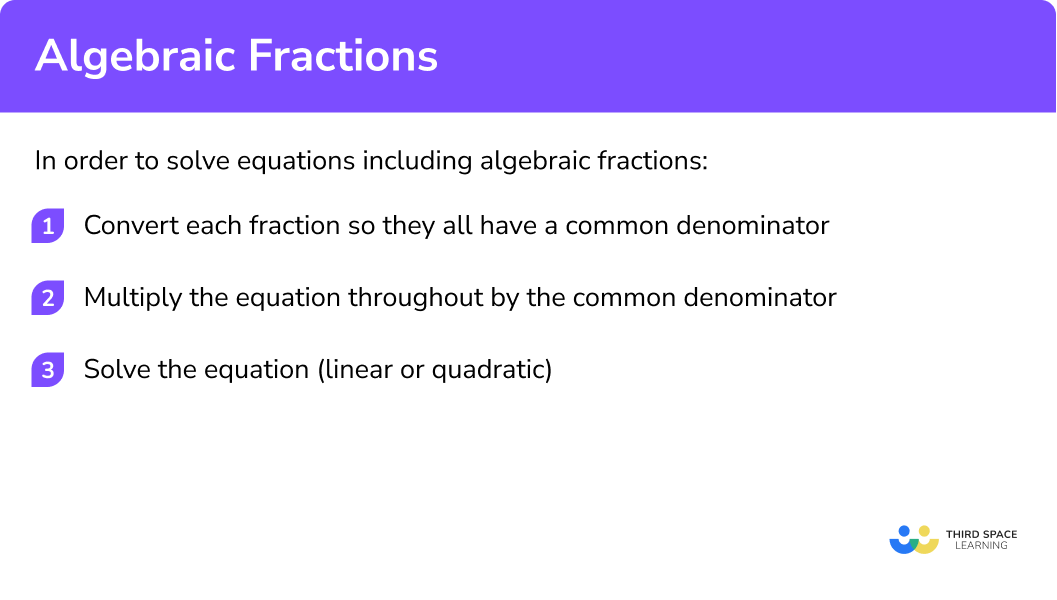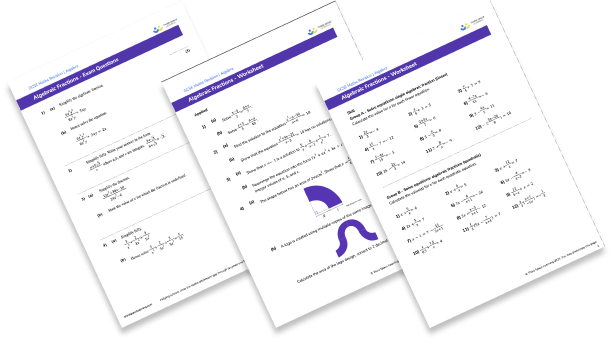GCSE Tutoring Programme
Our chosen students improved 1.19 of a grade on average - 0.45 more than those who didn't have the tutoring.
In order to access this I need to be confident with:
Fractions Simplifying fractions Adding and subtracting fractions Rearranging equations Solving equations Quadratic equations (factorisation) Quadratic formula Expanding brackets Simultaneous equationsThis topic is relevant for:

Algebraic Fractions
Here we will learn about algebraic fractions, including operations with fractions, and solving linear and quadratic equations written in the form of algebraic fractions.
There are also algebraic fractions worksheets based on Edexcel, AQA and OCR exam questions, along with further guidance on where to go next if you’re still stuck.
What are algebraic fractions?
Algebraic fractions are fractions that contain at least one variable.
The following algebraic expressions are examples of algebraic fractions:
x is the numerator:
\quad \quad \quad \frac{x}{12}
Both the numerator and the denominator contain an x term:
\quad \quad \quad \frac{x+1}{2x}
An expression in terms of x is the denominator:
\quad \quad \frac{3}{x+1}\
Both the numerator and the denominator contain an expression with x :
\quad \quad \frac{3x+4}{2x-5}
The numerator is a multiple of x :
\quad\quad \quad \quad \frac{2x}{15}
The numerator and the denominator are quadratic expressions:
\quad\quad \quad \quad \frac{(x+3)^{2}}{x^{2}-9}
The main aim of this lesson is to understand how to solve equations that include algebraic fractions.
All the examples above are expressions whereas the examples below are equations as we can find specific values for
E.g.
One step equation:
\quad \quad \frac{x}{12}=4
A separate constant term:
\quad \frac{x+1}{2x}+4=x
A quadratic equation:
\quad\frac{3}{x+1}=x+5
A linear equation:
\quad \frac{3x+4}{2x-5}=6
A second fraction:
\quad \frac{2x}{15}=\frac{5x}{2}
Double brackets, difference of two squares and simultaneous equations:
\quad \frac{(x+3)^{2}}{x^{2}-9}=2x-1
It is important to be able to simplify algebraic fractions into their simplest form. If you need to practice this or need a quick refresher, see the lesson on simplifying algebraic fractions for further information.
Step-by-step guide: Simplifying algebraic fractions
What are algebraic fractions?

How to solve equations including algebraic fractions
We need to be able to solve equations including algebraic fractions.
Let’s look at a simple example when \frac{8}{x}=2 .
Here, the denominator of the fraction contains the variable, so we first need to get the variable out of the denominator.
Rearranging the equation by multiplying both sides by x and then dividing by 2, we get the value of x=4.
We can substitute this into the original equation to prove that the answer is correct.
Here, \frac{8}{4}=2 so we have the correct answer.
We shall now consider more complicated cases when equations involve algebraic fractions.
In order to solve equations including algebraic fractions.
- Convert each fraction so they all have a common denominator.
- Multiply the equation throughout by the common denominator.
- Solve the equation (linear or quadratic).
Explain how to solve equations including algebraic fractions


Algebraic fractions worksheet

Get your free algebraic fractions worksheet of 20+ questions and answers. Includes reasoning and applied questions.
DOWNLOAD FREE
Algebraic fractions worksheet

Get your free algebraic fractions worksheet of 20+ questions and answers. Includes reasoning and applied questions.
DOWNLOAD FREEAlgebraic fractions examples
Example 1: Equation with one fraction
Solve the equation
\frac{2x-1}{3}+x=3- Convert each fraction so they all have a common denominator.
Here, we only have one fraction and so we do not need to convert any other term into a fraction.
2Multiply the equation throughout by the common denominator.
Multiplying the equation throughout by 3 (the denominator of the fractional term), we get
Make sure that you multiply every term in the equation by 3 .
3Solve the equation (linear or quadratic).
You can check your solution by substituting the value for x into the original equation and evaluating it.
Here,
Example 2: Equation with two fractions
Solve the equation
\frac{x+1}{2}+\frac{x+3}{5}=6Convert each fraction so they all have a common denominator.
Here, we have the two fractions with the denominators of 2 and 5 . The lowest common multiple of 2 and 5 is 10 and so we can convert the two fractions so that they have the same denominator.
Remember to use brackets to ensure that you multiply the entire numerator by 5 .
Remember to use brackets to ensure that you multiply the entire numerator by 2 .
We now have the equation
Multiply the equation throughout by the common denominator.
Multiplying the equation throughout by 10 (the denominator of the fractional terms), we get
Solve the equation (linear or quadratic).
You can check your solution by substituting the value for x into the original equation and evaluating it.
Here,
Example 3: Equation with x in the denominator
Solve the equation
3-\frac{5}{x+1}=1Convert each fraction so they all have a common denominator.
Here, we have one fraction so we do not need to find a common denominator.
Multiply the equation throughout by the common denominator.
Multiplying the equation throughout by x + 1 (the denominator of the fractional terms), we get
Solve the equation (linear or quadratic).
You can check your solution by substituting the value for x into the original equation and evaluating it.
Here,
Example 4: Equation with three fractions
Solve the equation
\frac{1}{x}+\frac{1}{2x}+\frac{1}{3x}=11Convert each fraction so they all have a common denominator.
Here, we need to find the lowest common multiple of x, 2x, and 3x . As x is the highest common factor, x \times 1 \times 2 \times 3 is the lowest common multiple, which is equal to 6x. .
So by multiplying the numerator and denominator of each fraction by a constant, we can convert each fraction to have the common denominator of 6x:.
We now have an equation which we can immediately simplify.
Multiply the equation throughout by the common denominator.
Multiplying the equation throughout by 6x (the denominator of the fractional terms), we get
Solve the equation (linear or quadratic).
You can check your solution by substituting the value for x into the original equation and evaluating it.
Here,
Example 5: Denominators are expressions in terms of x
Solve the equation
\frac{x+1}{x+2}+\frac{3}{x-4}=1Convert each fraction so they all have a common denominator.
Here, we need to find a common denominator for (x + 2) and (x − 4) .
The easiest way to do this is to multiply the two expressions together.
Top tip: do not expand the brackets too soon as you may be able to simplify the fraction before solving the equation.
By multiplying each fraction by the denominator of the other fraction, we get
We now have an equation which we can immediately simplify.
Multiply the equation throughout by the common denominator.
Multiplying the equation throughout by (x+2)(x-4) (the denominator of the fractional term), we get
Solve the equation (linear or quadratic).
You can check your solution by substituting the value for
Here,
Example 6: Equation including a quadratic
Solve the equation
\frac{9x+4}{x}=-2xConvert each fraction so they all have a common denominator.
Here, we have a single fraction and so we do not need to find a common denominator.
Multiply the equation throughout by the common denominator.
Multiplying the equation throughout by x (the denominator of the fractional terms), we get
Solve the equation (linear or quadratic).
You can check your solution by substituting the value for x into the original equation and evaluating it.
Here, we have two possible solutions for x so we can check both:
Common misconceptions
- Multiplying the numerator by the denominator
Let us look at example 2 . When multiplying throughout by 10 to remove the denominator from each fraction, the numerator has also been multiplied by 10 .
This means that the fractions have been multiplied by 100 , instead of 10 , leaving the next line of work to be incorrect.
- Ignoring the denominators
When given an equation including an algebraic fraction, if the denominators are ignored the question will be answered incorrectly.
- Not multiplying all terms by the denominator
When rearranging an equation, the denominator is moved to the other side of the equals sign, instead of each term being multiplied by it. You must remember to multiply throughout by any value, not just the opposite side of the equals sign.
- Simplifying fractions incorrectly (1)
When adding two fractions, the denominator must be the same. A common misconception for adding two fractions is to add the numerators and the denominators together because this method is emphasised when looking at multiplying fractions.
- Simplifying fractions incorrectly (2)
Seeing the same term on the numerator and denominator allow the misconception that they can both be cancelled.
Practice algebraic fractions questions
1. Solve the equation
\frac{x+5}{3}+x=7




2. Solve the equation
\frac{x+5}{2}+\frac{5+x}{2}=50




3. Solve the equation
7+\frac{6x+4}{8}=2x




4. Solve the equation
\frac{5}{x}+\frac{2x}{5}=3




5. Solve the equation
\frac{6-x}{4}+\frac{12}{4-x}=4




6. Solve the equation
\frac{5}{8+x}+\frac{6-x}{9}=2




Algebraic fractions GCSE questions
1. Arron earns £40 per hour. One day, he receives a bonus of £5 . He shares this day’s earnings equally with his brother and sister. If he gives away £190 , how many hours did Arron work that day?
(2 marks)
(1)
x=7
(1)
2. Use the quadratic formula to solve the equation
\frac{2x}{x+3} + \frac{5x}{x+2} = 4
(6 marks)
2x(x+2)+5x(x+3)=4(x+3)(x+2) or equivalent
(1)
7x^{2}+19x=4x^{2}+20x+24
(1)
3x^{2}-x-24=0
(1)
x=\frac{-1\pm\sqrt{1^{2}-4\times1\times{-24}}}{2\times{3}}
(1)
x=\frac{1\pm{17}}{6}
(1)
x=3 or x=-\frac{8}{3}
(1)
3. Two shapes given below have the same area. Calculate the value for x .
(7 marks)
Area of Triangle = \frac{2(x+8)}{2}=x+8
(1)
Area of Square = \left(\frac{3}{\sqrt{x}}\right)^{2}=\frac{9}{x}
(1)
x+8=\frac{9}{x}
(1)
x^2+8x-9=0
(1)
(x+9)(x-1)=0
(1)
x=1 or x=-9
(1)
Conclusion: x=1 only
(1)
Learning checklist
You have now learned how to:
-
use algebraic methods to solve linear equations in 1 variable (including all forms that require rearrangement)
-
simplify and manipulate algebraic fractions
The next lessons are
Still stuck?
Prepare your KS4 students for maths GCSEs success with Third Space Learning. Weekly online one to one GCSE maths revision lessons delivered by expert maths tutors.

Find out more about our GCSE maths tuition programme.